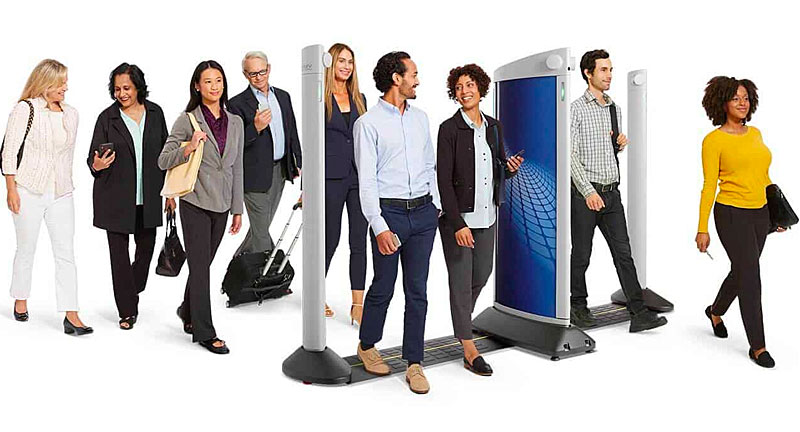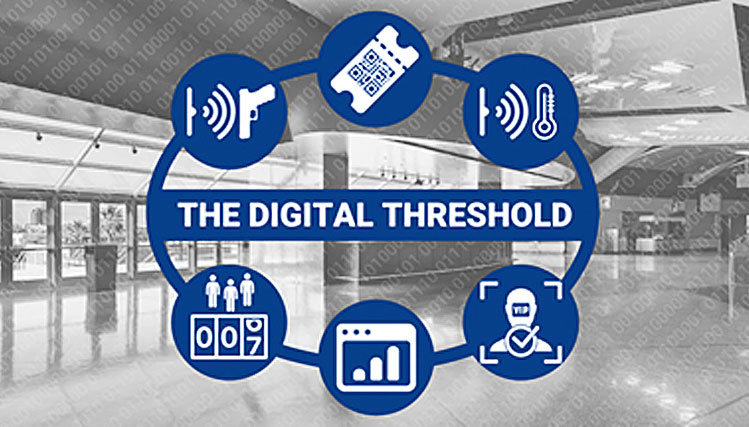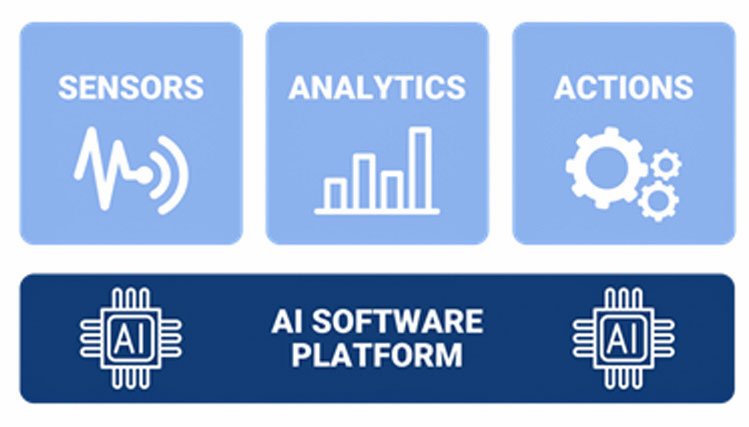
By Peter George, CEO, Evolv Technology
The New Normal
Throughout this global pandemic period I’ve had many conversations with leaders responsible for people screening at live sports and entertainment venues, workplaces, schools, houses of worship, and outdoor theme parks across America.
We’ve all felt a pandemic anxiety. Along with our heroic first responders, few feel it more acutely than these men and women responsible for helping people safely gather in a time when the act of gathering itself has become a mortal threat.
Their entire world was shut down and is now in the process of reformatting and rebooting.

Most of the security leaders I am talking with are struggling with how to reopen safely, attract visitors, and stay open indefinitely.
One thing I know for sure: there will be no going back to the old screening procedures.
Why? Because three waves of change are combining to crest and crash down on the thresholds of their venues at the same time. The future of people screening will be quite different indeed, but it will be much, much better—at least for those who learn to adapt.
So, what are these three waves of change?
They are the Normalization of Pandemics, Armed Anxiety, and the Digital Transformation of Physical Security. Let’s look at each in detail.
Wave 1: Normalization of Pandemics
Pandemic viruses turn unwitting visitors into weapons. COVID-19 has weaponized people in a way never seen before. Everyone now knows that packed crowds and human contact multiply the danger.

Visitors and employees are looking at every venue and workplace with new eyes and formulating an internal risk score based on what they see. They are highly sensitized and are looking for evidence that the operators “get it” and have taken action.
They don’t always know what they should expect, but they absolutely will expect security screening to be visibly different. COVID-19 has changed the risk profile of gatherings forever. A pandemic-aware security posture is the new normal.
Traditional high-touch entry screening is obsolete.
Helping visitors feel safe in the new environment while delivering a financially sustainable entry throughput is just not possible with old metal detectors, manual bag inspections, and the resulting crowds.
Along with new regulations and mandated protocols that venues must abide by, visitors and employees now also want to see a very orderly, safe, and socially-distanced people flow.
A touchless visitor experience is part of the new normal.
A pandemic-aware security posture is not some passing fad. There have been six serious pandemics in just the last two decades: SARS, MERS, avian flu, swine flu, Ebola, and now COVID-19.
Will there be more? Absolutely. Every physical security team must now develop the ability to adapt to future pandemics that are certainly on the way. Ongoing pandemic readiness is part of the new normal.
Evolv Technology customers, such as Six Flags and Hersheypark, have adapted to the pandemic by rolling out a new comprehensive health and safety plan for reopening their amusement parks.
In the case of Six Flags, they’ve added thermal imaging for identifying guests with elevated body temperature and Evolv’s touchless security screening as part of their social-distancing procedures.
(See how Evolv Express is being implemented into Six Flags Extensive New Safety Measures for Reopening Parks, for the world’s largest regional theme park company and the largest operator of waterparks in North America (at :29). Courtesy of BusinessWire and YouTube.)
We believe this is the beginning of a new trend of multi-threat screening that is changing venues and guest experiences forever.
Wave 2: Armed Anxiety
Research shows that there are as many as 393 million privately owned guns in circulation in the United States. The recent pandemic has spurred a new surge in gun purchases. More guns were sold in the first eight months of 2020 than were sold in all of last year.
While most crime has significantly declined during the pandemic, shootings and killings remain at pre-pandemic levels.
Soon after pandemic lockdown orders started to lift, there was a venue-targeted active shooting incident in Arizona, and other active shooter incidents in Kansas and Texas.
In 2020 the U.S. is on track to have an all-time record year for mass shootings, having reached the 2019 total of 417 on September 2, with four months still left to go.
(There have been 28 murders in Cincinnati so far in 2020; there were just 16 at this time in 2019. And while more than doubling the number of murders is troubling, it pales in comparison to the rate of violent crime in the past 30 days. Homicides are up 270%. Aggravated assault is up 60%. And while robberies are steady and rapes have actually dropped by 40%, the murder and assault spikes are alarming. Courtesy of Local 12 and YouTube. Posted on May 4, 2020.)
The fact that shooting incidents persist amid the pandemic is unsurprising when we consider the historic levels of depression and anxiety that people are experiencing right now.
The CDC reports that 40% of U.S. adults reported struggling with mental health or substance abuse during the pandemic—with the prevalence of anxiety being three times higher and depression four times higher than the same period last year.

The combination of an unprecedented number of weapons and unprecedented levels of anxiety and depression creates an unprecedented danger.
We are living in an era of armed anxiety. Even though people are not gathering at scale today, that will change someday soon.
Any gathering or workplace could be the next target. Any employee or visitor could suddenly erupt into the next violent threat. It could happen anywhere at any time.
Wave 3: The Digital Transformation of Physical Security
Outside the physical security world, businesses in every industry are unlocking efficiency and value by digitizing old manual and analog processes.
They are re-imagining their organizations and operations in a future defined by software, data, sensors, mobility, networks, machine learning, automation, and analytics.
It isn’t change for the sake of change; it’s change to allow the business to perform better in the modern world and be ready to respond more quickly to change in the future.

Anheuser-Busch InBev is using machine learning to help bars create more accurate orders, resulting in better customer satisfaction. Walmart is using shelf-scanning robots to optimize inventory performance. Black & Decker is using networked sensors to track the movement of materials in factories to increase labor efficiency and quality.
Is digital transformation worth the effort? Yes, with the greatest rewards going to those who start early and do it right.
Across all industries, digital leaders clearly outperform the laggards in their industry in both growth and profitability according to recent Bain & Company research:
After comparing financial results for five categories of companies based on their degree of digital maturity, Bain found that revenues for the digital leaders grew 14 percent over the past three years, more than doubling the performance of the digital laggards in their industries. Profitability followed a similar pattern—83 percent of the leaders increased margins over that period while less than half of the industry laggards did so.
Unfortunately, physical security stands out as a laggard in digital transformation—especially when compared to the modern cybersecurity best practices that I am used to.
Consider the findings of Accenture and Microsoft in their recent survey of physical security leaders:
“We found that although security leaders see the opportunity to enhance risk management with digital capabilities, the industry is at various levels of maturity, and at worst is a decade behind. Respondents identified “reactive threat management” and “intuition-led decision-making based on subjectivity” as the two leading challenges facing physical security operations today. These challenges—operating reactively and improving decision-making—make it difficult to be proactive. This puts your people, brand and reputation at risk.”
It’s not surprising that physical security managers are worried about “reactive threat management” and “intuition-led decisions” when their security screening technology hasn’t fundamentally changed since the 1920s and is completely devoid of digital data.
Old analog metal detectors, hand wands, and manual bag inspections are artifacts of a pre-digital age. Weapons screening sometimes feels like the land that time forgot.
Today’s lack of modern technology in physical security operations has created an undue reliance on security staff.

The security officers are burdened with an ever-growing list of tasks: watch out for bad behavior, answer guest’s questions, handle minor incidents, and clean up the physical space, in addition to the core screening role of manually checking everybody entering for prohibited items.
There are simply too many things for any one security guard to manage.
Things could not be more different in the cybersecurity part of the business.
Because cybersecurity was born inherently digital, cybersecurity professionals are immersed in oceans of digital data and refined pattern recognition based on cutting edge artificial intelligence.
They have deep and meaningful analytics and real-time threat intelligence that help them adapt to new threats, in real time, and continuously tighten their perimeter.
The Rise of the Digital Threshold
How long will it be until we close the gap between the digital haves in cyber and the digital have-nots in physical security? It’s already happening.
A new vision and technology architecture are emerging. We call this vision the Digital Threshold.
The Digital Threshold vision applies the proven patterns of digital transformation and cybersecurity to everything that happens in the space people cross as they enter and exit modern venues and facilities.
Within the Digital Threshold vision, venues and facilities can intelligently use data to create a frictionless experience for guests and employees. The result is an entry process that enhances the overall experience instead of diminishing it as it so often does today.
Making weapons screening faster and more precise is part of the Digital Threshold vision, but it’s just the beginning.
What if the entry experience could also seamlessly integrate digital health screening and health credential processing into the screening process?
What if electronic ticketing, VIP identification, and BOLO alerts could also be part of the same seamless flow?
And what if the Digital Threshold generated useful analytics that enable data-driven decisions about system adjustments and people flows?
All of this is part of the Digital Threshold vision that not only addresses the current environment, but also creates the ability to adapt and flex to handle future needs as necessary.
The Digital Threshold as a Technology Architecture
The Digital Threshold is more than just a vision for frictionless entry experiences—it’s a digital technology architecture of components that work together to realize the vision.
These components include Sensors, Analytics, and Actions, all on top of the AI Platform.
Sensors
In the Digital Threshold vision, sensors work together to spot multiple threats and to supply useful insights about visitors. Each sensor fills in a different part of the picture.
Data from magnetic field sensors make it possible to see the difference between a gun and a smartphone. Thermal imaging cameras provide the raw data that makes it possible to spot people with elevated body temperature—a sign of potential infection.
(Evolv Express™ is the world’s first and only touchless security screening solution that meets all of the post-pandemic security screening requirements. Express is up to 10X faster and far more accurate than metal detectors because it uses new sensor technology and artificial intelligence. Visitors walk right through at a natural pace while carrying their phones, bags and other personal items. Courtesy of Evolv Technology and YouTube. Posted on Aug 27, 2020.)
Visible light cameras could gather the imagery needed to count visitors, estimate visitor demographics, and identify visitors as employees, VIP season pass holders, or known threats.
Microphones, biometric and credential readers, and other types of sensors could supply added insights about who and what is coming through the Digital Threshold.
As threats evolve and new sensors emerge, the Digital Threshold sensor array can expand as needed. Rather than sending visitors through an obstacle course of standalone technologies, the Digital Threshold allows venues to touchlessly screen for multiple threats in a single concept of operation (CONOP).
AI Software Platform
Digital Threshold sensors produce a flood of raw digital data that must be stored, organized, and turned into meaningful information. That’s where the AI software platform comes in. It’s the brains of the Digital Threshold vision.
AI uses machine learning to spot complex patterns in data. More data and more kinds of data make machine learning models more precise over time. Having multiple digital sensors makes it possible to bring everything together in a way that increases situational awareness.
The core value of the Digital Threshold vision is embodied in software.
The hardware is almost incidental and will someday come in many different forms. Instead of installing new hardware to improve accuracy, the machine learning models could be upgraded just like the software on smartphones.
(See Evolv Express in Action at a Convention Center. Courtesy of Evolv Technology and YouTube. Posted on May 27, 2020.)
This completely changes the game of system upgrades. As the Digital Threshold gets smarter over time, rolling out new capabilities becomes a matter of clicks, not forklifts.
At Evolv, we call our AI software platform the Evolv Cortex AI™. From the beginning we designed Cortex AI to be upgradable and extensible across a wide variety of threats. It’s the brain of all our products and an early expression of the Digital Threshold vision.
Actions
When the AI software platform identifies a problem, imagine if the Digital Threshold action flow engine could spring into action to orchestrate the appropriate response. It’s about much more than beeps and alarms.
Imagine if visitors could see a temporary “Slow Down” message when sensors detect crowding that violates social distancing requirements.
If a potential weapon is spotted, the visitor might be visually directed to a weapon screening resolution station on the left, while a person with elevated body temperature could be directed to a health screening station on the right.
Season ticket holders might be greeted with a “Welcome Back!” display.
Whatever the situation, the Digital Threshold could guide visitors and guard staff with a suitable programmed response. The key word is programmed.
Because it would be a software workflow engine, actions could be changed and customized over time without a hardware upgrade. It’s software-defined physical security that could prove to be just as revolutionary as software-defined networking.
Analytics
Because the Digital Threshold feeds on digital data, it could become possible to generate an ever-growing number of useful analytics to help plan and execute a frictionless experience.
For example, based on the type of event, day of the week, forecast weather, and current tour of a specific performer, a Digital Threshold-equipped venue manager could potentially answer questions like the following:

-
What time did the arrival rate peak before last week’s event?
-
What is the mix of families and demographics of individuals coming through different entrances?
-
Is entrance throughput consistent with our social distancing guidelines?
-
Which doors seem to attract the most VIPs?
-
What are the demographic characteristics of our visitors by entrance?
-
What is the alarm rate at each entrance?
-
What are the top threats detected at each entrance?
Once the data is in an analytics platform, there is almost no end to the questions we might answer.
Remember the Accenture and Microsoft research finding that physical security managers were worried about “intuition-led decisions?” Having powerful analytics could be a huge step down the path to data-driven decision-making.
These analytic insights not only keep people safely moving based on their risk profile but also allow for venues to monetize the visitor experience more effectively.
Toward Agile Readiness
These four components of the Digital Threshold come together to transform the screening process to both block today’s known threats and quickly adapt to future threats as they emerge.
I call this the state of “Agile Readiness.” Modern venues with agile readiness can quickly flex and surge into whatever comes next.
While it is impossible to specifically predict every new threat, digital technology makes it possible to reduce the window of exposure and minimize disruption.
It’s about generating, harnessing, and trusting data to make the most important decisions about safety instantaneously. It’s about maintaining a security posture that engenders trust and confidence among employees and visitors.
It’s security that is obvious but low-profile, strong but not invasive, fast but not cumbersome. That’s what the Digital Threshold vision could deliver, creating Agile Readiness.
Software Eats the World of Physical Security

Web pioneer Marc Andreessen has famously claimed that “software is eating the world” and I completely agree with him. The most interesting thing about cars these days is the software that makes them more efficient and safer.
The most interesting thing about a watch these days is the software that makes it a fitness and health tracker and an extension of my phone rather than just a timepiece.
The hardware of modern technology is still important, but more often only as a vessel for the innovative software it contains.
At Evolv, we are bringing the “software eats the world” phenomenon to security screening, and it’s already creating incredible value for our customers.
Our early implementation of the Digital Threshold vision is successfully devouring the old security screening technologies, and it shows no signs of slowing down.
It’s also empowering security teams to do an even better job of keeping people safe while optimizing financial and staff resources.
The software platform supplies the brain and connective tissue to integrate capabilities of new emerging technologies that transform the new visitor or fan experience.
It becomes the security platform to seamlessly integrate biometrics, video analytics, crowd intelligence, health posture data, electronic ticketing, and on-demand liability wavers to allow for a frictionless/contactless visitor, employee, and fan experience in a post COVID-19 world.

We have made substantial progress in realizing the Digital Threshold vision in the Evolv product line.
Customers are telling us we have it right, but in many ways, we are just getting started.
There’s a lot of room left to apply artificial intelligence to physical security, including new types of sensors to consider and analytics to create. It’s an extremely exciting time.
Addressing the realities of pandemics and armed anxiety while also developing the potential of digital transformation will require a new approach.
We must reimagine these challenges and opportunities in a whole new light, unbound by legacy technologies or preconceived, outdated ideas.
Armies of people using old ways of working simply cannot keep the public safe. The old solutions don’t scale wide enough or deep enough to address these threats everywhere they can appear.
Much like we’ve seen in other industries, technology can fundamentally bend the curve back in our favor and return peace of mind. And peace of mind is what we all want and deserve, now more than ever.
One Chance to Get it Right
I believe that the realization of the Digital Threshold vision is inevitable, and the time to get started is now. I also believe that the transition will create winners and losers.
Facilities that embrace and adapt to the digital future will earn lasting trust and long-term viability and loyalty. Facilities that are slow to adapt may never recover from the resulting loss of business and trust.

If you’d like to join us on the journey toward the Digital Threshold, consider viewing Evolv’s Digital Threshold Live webcast series – a series of webcasts featuring new guest speaker from a variety of industries, moderated by Evolv Technology’s Co-founder & Head of Corporate Development, Anil Chitkara.
We’ll be speaking with leading experts to explore the business drivers, technologies, and human dimensions of the Digital Threshold vision.
About the Author
Peter George is high-energy and proven global Chief Executive Officer with an impressive track record in the security, software, and networking industries.
He has achieved success in growing and scaling both early stage venture capital companies and larger private equity companies to successful exits.

Developing long-term strategy and building high-performance teams who deliver outstanding results through world-class execution, is one of Mr. Georges’s greatest strengths along with his exceptional communication skills with ability to identify, reach, and inspire all stakeholders.
“I am a company builder and business leader who is passionate about mission-driven organizations,” according to Mr. George.
“Throughout my career in technology, I have been focused on bringing new products to market and leading companies to global growth. My approach to business is to stay grounded in clear, direct, and honest communication and lead teams who have deep expertise in their field.”
Evolv Technology Wins Platinum in 2020 ‘ASTORS’ Awards Program
 American Security Today’s ‘ASTORS’ Homeland Security Awards program is in its Fifth Year and continues to recognize the Outstanding Innovations of top firms and agencies in the Homeland Security and Public Safety fields.
American Security Today’s ‘ASTORS’ Homeland Security Awards program is in its Fifth Year and continues to recognize the Outstanding Innovations of top firms and agencies in the Homeland Security and Public Safety fields.
2020 has been a very challenging year for everyone due to the COVID-19 pandemic and the much heralded AST ‘ASTORS’ Awards Winners Presentations and exclusive Luncheon at the Jacob Javits Center in NYC has been canceled and rescheduled for 2021 due to the virus.

However, the 2020 ‘ASTORS’ Homeland Security Awards Program was again a huge success and many new categories were added including a section for COVID-19 Detection and Innovation.
Evolv Technology
Best Weapons Detection Solution
-
Evolv Express™
-
-
Evolv Express is a touchless high-speed smart firearm and bomb detection system that screens over 3600 people per hour (60 people per minute) and gets smarter over time.
-
-
-
With Evolv, it is possible to deter and prevent active shooters and bombers from entering a venue without sacrificing the visitor experience.

-
With Evolv’s advanced sensors and machine learning, organizations can automatically screen for concealed weapons on all employees, contractors and visitors entering a workplace, facility, building, etc., without slowing down operations.
-
Evolv Express is a proven solution for fast, contactless weapons screening while offering a hassle-free visitor experience and the social distancing necessary in these uncertain times.
-
Second only to the TSA, organizations using Evolv have screened more than 50 million people to-date in a rapid, undisruptive manner while preventing more than 5,000 weapons from entering schools, sports stadiums, concert halls, places of work, houses of worship, government facilities and other public venues.
-
Evolv’s AI-based, free-flow weapons-screening and threat detection systems work at the pace of life to accommodate thousands of individuals and groups per hour.
-
Evolv Technology was also recognized in the 2019 and 2018 ‘ASTORS’ Homeland Security Awards Programs.
Evolv Technology, a leader in security screening, provides touchless security screening that ensures safety by spotting concealed weapons and potential virus infection threats using advanced digital sensors and modern artificial intelligence that is accurate, discrete and delivers three to five times more throughput than older technologies.
For more information on the 2020 ‘ASTORS’ Awards Program and advertising opportunities with American Security Today, please contact Michael Madsen, AST Publisher at mmadsen@americansecuritytoday.com.
AST strives to meet a 3 STAR trustworthiness rating, based on the following criteria:
- Provides named sources
- Reported by more than one notable outlet
- Includes supporting video, direct statements, or photos




















